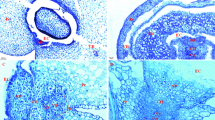Abstract
Three groups of winter wheat (Triticum aestivum L.) genotypes having spike fertility genes (SFG) were used in field trials: (1) Tetrastichon sessile spikelets (TSS), (2) Normal spikelets (NS), (3) Indeterminate rachilla spikelets (IRS). The capacity of conducting system of the peduncle and the ear sink capacity of the main stem have been measured. There was a highly significant positive correlation (r = 0.899 and higher) between peduncle diameter and parameters quantifying peduncle vascular system. Compared with the control cultivar Hana, the TSS and NSS genotypes had higher both the number of vascular bundles, phloem and bundle cross section area and kernel number per ear. However, the highest kernel number per ear was found in the IRS genotypes although their bundle and phloem area was only equal or even lower then that of the variety Hana. Further studies are needed in developmental anatomy of spikes and stems to elucidate also differences in the relationships between the conducting capacity and kernel number per spikes in the TSS, NS and IRS genotypes.
Similar content being viewed by others
References
Brandie, J. E., Knott, D. R.: The effect of a gene for semidwarfism (Rht 1) on various characters in a spring wheat cross.- Can. J. Plant Sci.66: 529–533, 1986.
Brooking, I. R., Kirby, E. J. M.: Interrelationships between stem and ear development in winter wheat: the effects of a Norin 10 dwarfing gene, Gai/Rht 2. - J. agr. Sci.97: 378–381, 1981.
Evans, L. T., Dunstone, R. L., Rawson, H. M., Williams, R. F.: The phloem of the wheat stem in relation to requirements for assimilate by the ear. - Aust. J. biol. Sci.23: 743–752, 1970.
Hamid, Z. A., Grafius, J. E.: Developmental allometry and its implication to grain yield in barley. - Crop Sci.18: 83–86, 1978.
Housley, T. L., Peterson, D. M.: Oat stem vascular size in relation to kernel number and weight. I. Controlled environment. - Crop Sci.22: 259–263, 1982.
Kadkol, G. P., Halloran, G. M.: Development and floret survival in wheat ears with supernumerary spikelets. - Ann. Bot.62: 559–568, 1988.
Lupton, F. G. M.: Further experiments on photosynthesis and translocation in wheat. - Ann. appl. Biol.71: 69–79, 1972.
Nátrová, Z.: [Conducting capacity in the peduncle of winter wheat varieties differing in their ear productivity.] In Czech. - Rost. Vyroba33: 1085–1091, 1987.
Pennel, L., Halloran, G. M.: Influence of vernalization and photoperiod on supernumerary spikelet expression in wheat. -Ann. Bot.53: 821–831, 1984.
Pushkarenko, A. Ya.: [Structural pattern of vascular system in the peduncle of various winter wheat varieties.] In Russ. - In: Sb. nauch. Tr. vsesoyuz. selskokhoz. gos. Inst. Odessa. Pp. 45–50. 1984.
Smocek, J.: [Phenocopies of gene spike fertility in wheat.] In Czech. - Rost. Výroba33: 529–537, 1987.
Wardlaw, I. F.: The early stages of grain development in wheat: Response to light and temperature in a single variety. - Aust. J. biol. Sci.23: 765–774, 1970.
Author information
Authors and Affiliations
Rights and permissions
About this article
Cite this article
Nátrová, Z., Mladičová, I. Quantitative characteristics of the conducting system in stem of winter wheat genotypes with spike fertility genes. Biol Plant 33, 484–490 (1991). https://doi.org/10.1007/BF02897724
Received:
Accepted:
Issue Date:
DOI: https://doi.org/10.1007/BF02897724




